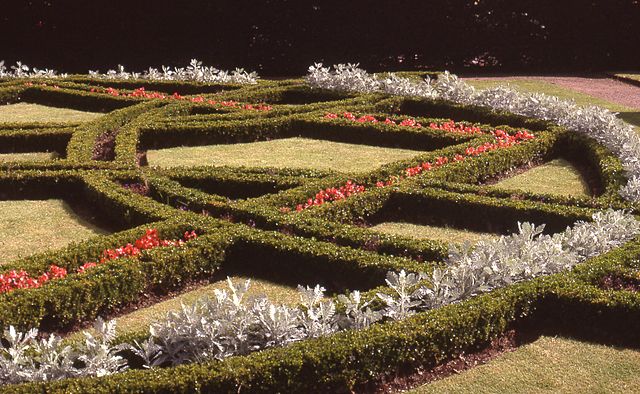My dear family friend, Susan, is here today. She has a great article for you on gardens and finding inspiration everywhere in your life! You are going to love it!
__________________________________________________________________________
How Does Your Garden Grow?
Creativity comes in many forms and some of the same skills one taps into when designing quilts and sewing projects can be applied to a garden as well. Colors, shapes, patterns, and even a little randomness all come into play.
In sixteenth century England, formal pleasure gardens were just coming into their own, thanks in part to the in-migration of professional gardeners from Italy and France and to social and cultural changes that brought more social order and security and meant that owners of the “big houses” (kings, earls, dukes, and the like) had more time and money to invest in pleasurable pursuits. Gardens thus became status indicators and were often very large and quite complex.
These gardens might include small orchards and all manner of shrubs, flowering plants, and herbs. They often featured walls or hedges enclosing smaller areas or sub-gardens, and gardeners employed walkways, arbors, benches, and even small hills known as “mounts.” Heraldry features and beast sculptures might be used to emphasize some element of family history or status, and sundials, fountains, fishponds, mazes, and topiary all eventually came into use.
The most notable feature of sixteenth-century gardens were knot gardens. These were usually a square composed of four “knots” —plants in an arrangement that resembled a knot—often surrounded by a railing or some other feature to set them off. Knot gardens are still found today, such as this one at St Fagans museum of country life in Wales:
Often gardens were laid out under windows or balconies to provide a vantage point from which to truly appreciate the design of the garden and its features. The value of this was brought home to me late last summer when I was up on a ladder holding something for my husband and happened to have my camera with me.
I could see how colors and shapes worked together:
And I could appreciate how I, like the Renaissance gardener, had incorporated places to stroll and places to sit and enjoy:
In 1577 a practical guide for gardeners appeared called The Gardener’s Labyrinth. Authored by one Thomas Hill, it remained in use for many decades, even in the “colonies.” Among it’s many illustrations is this one:
And another one features the gardener working in his raised beds, so mine are simply part of a tradition hundreds of years old:
Medieval gardens had generally been smaller of scale and used for growing plants and herbs for food and medicinal purposes. Those kinds of gardens certainly continued, as members of the lesser social classes would still have needed the garden’s bounty and would not have had time, money, or need for a formal pleasure garden. However, large or small, formal or not, I suspect that there have always been those who enjoyed the challenge and the beauty of growing things for their own sake. And, I’d like to think that rather than lions sculptured from shrubbery, one might simply have “guarden-cats”—living or not!

________________________________________________________________
Thank you Susan! I find inspiration for my quilts all the time in gardens. There are color combinations in gardens that I never would have thought of, but when I see them in nature I get suddenly inspired. PS. I love your “guarden cat”!







This is an inspiring post for me, since in the twenty-plus years we have lived in our home, we’ve done very little to actually landscape! Great ideas!
Love this article!! Wish I had more time to garden! 🙂
Thank you, Snoodles & Lisa! One of the things I have learned is that you can just pick one spot, of any size, that you get an idea for and go with it. The next year you can do another spot or add on to the one you did the year before. As you see how things take shape, new ideas will come to you. I am not a design person (I’m much better with words), but I love to work in the garden, so this method has given me lots of work to do and bit by bit things are taking shape. Remember to always take “before” pictures! I look back at the pictures I took five years ago when this yard was suffering from a serious case of twenty years of “bachelor-itis,” and I’m amazed at the difference.:-)
Great post, really enjoyed it and packed full of information! Thank you! Very inspiring!
I really enjoyed this post! I look down on my backyard from my second floor deck and never thought about turning it into a garden like that. It will take several years, but I hope to make a start this summer.
Thank you Sondra & Susan, and Susan I hope you enjoy developing your own garden. Many thanks also to Melissa for letting me be here today.